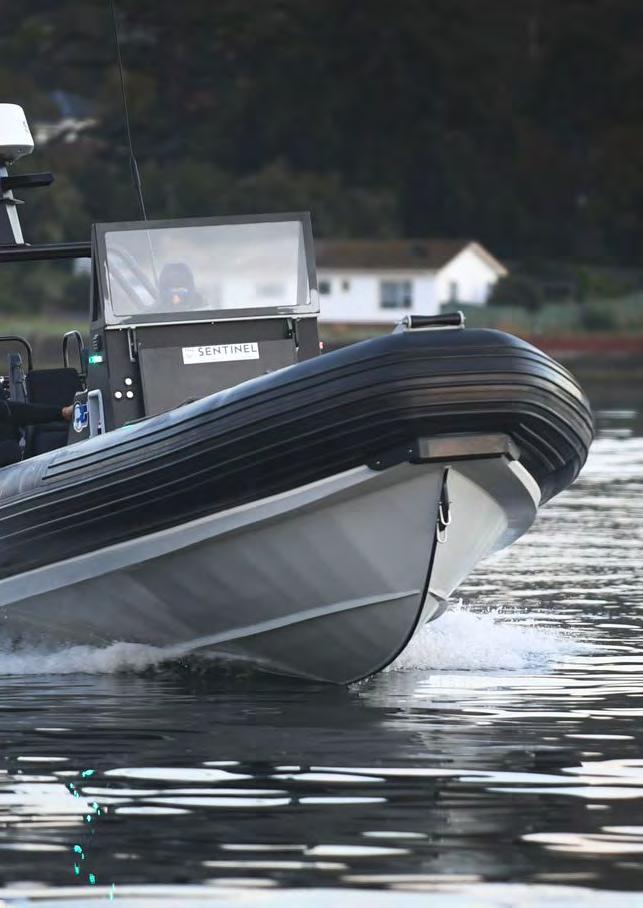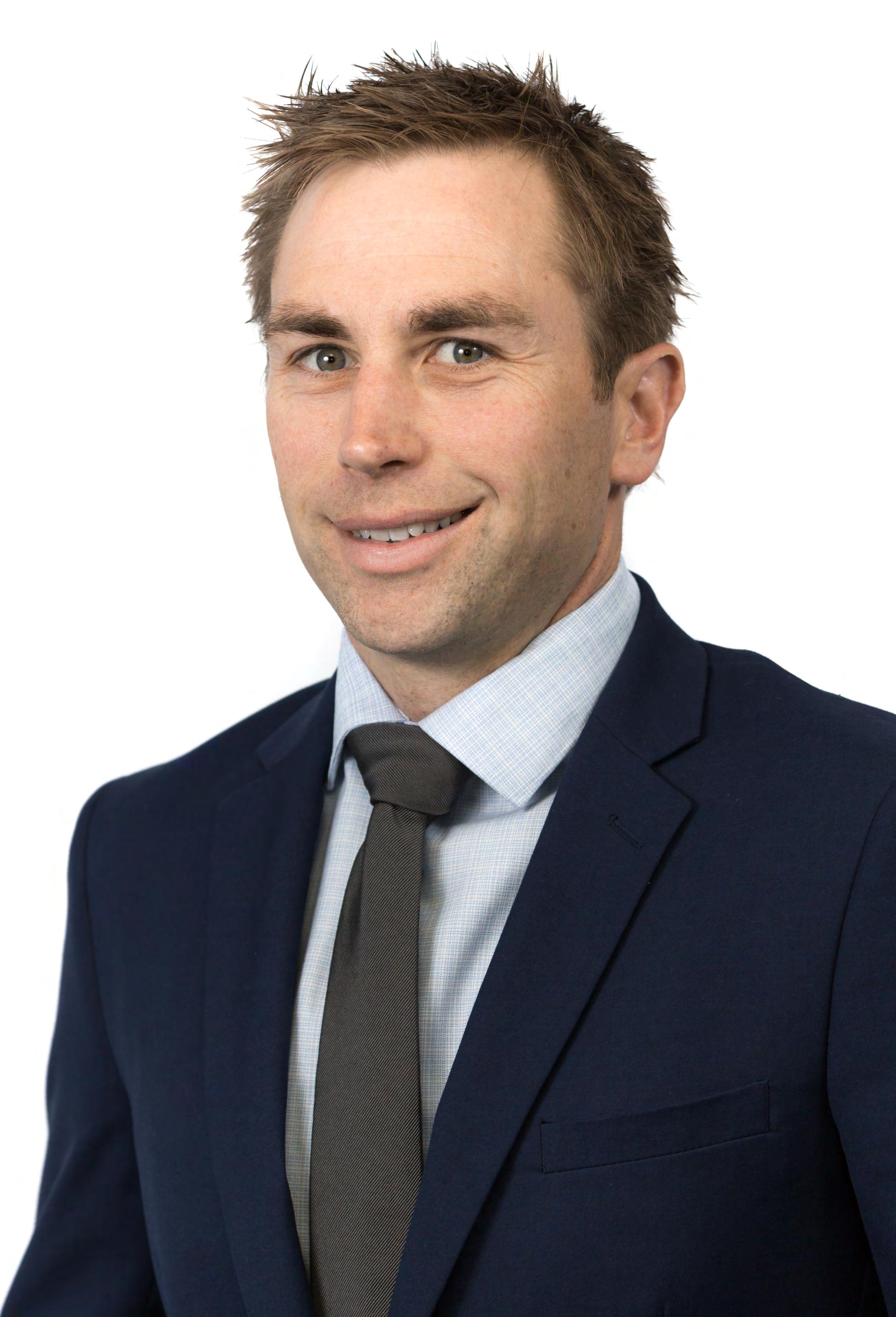
9 minute read
PFG
PROJECT DIRECTED BY Steve Owen
WRITTEN BY Laura Watling
Robert Inches, CEO, PFG
Robert Inches, with the PFG team
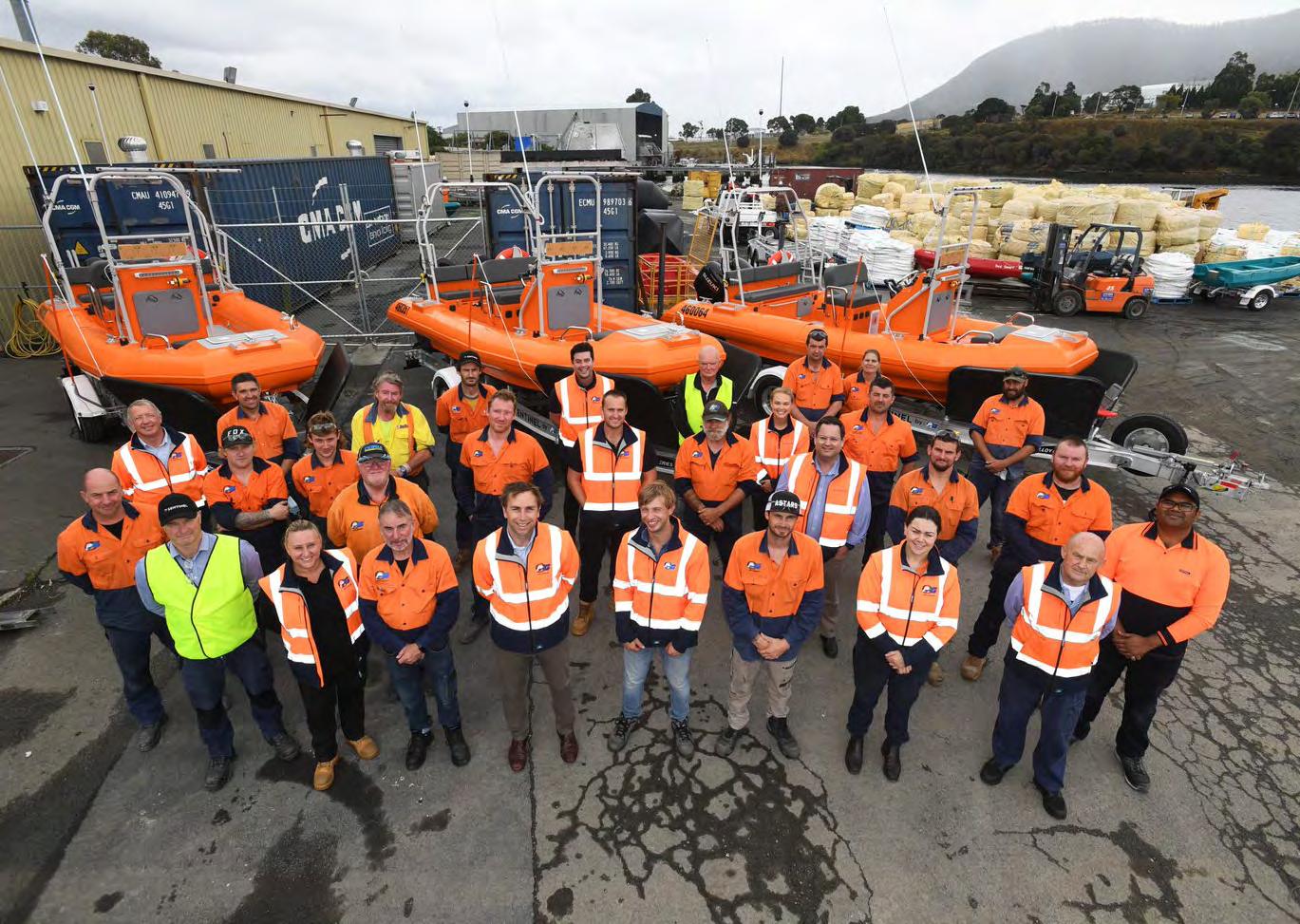
Catch of the Day
It’s this Tasmanian-headquartered manufacturer and boat builder’s mission to create the toughest, most reliable, highest-quality products for safety-critical industries. From its beginnings in the aquaculture industry, to manufacturing, work boats, and now elite tactical defence vessels, PFG’s evolution has driven industries forward. Laura Watling discovers more.
Headed up by CEO Robert Inches, PFG is a multi-sector, technology-based partner, creating durable products for use in harsh environments.
Born out of the requirement to produce high-performing and environment-resisting fish pens for the fledgling 1980s Tasmanian salmon industry, PFG has grown to become an award- winning business, providing turn-key solutions to every continent in the world.
Its origins in Southern Ocean industries makes the company’s DNA different. From the beginning, PFG was focussed on working closely with customers to solve gnarly problems. The company has always been about bespoke design, small-scale production, and uncompromising quality.
PFG
“In this harsh environment, you’re forced to design and build differently if you want products to withstand the elements and bring workers home safely,” said Mr Inches. “Failure is simply not an option.”
In addition to its stronghold in the aquaculture and marine industries, PFG works with businesses in the agriculture, civil works, and mining sectors. Its main business here is to replace products traditionally made from steel with custom-designed, fit-for-purpose products made from highly durable, cost-effective, polyethylene. The company is also the largest suppliers of plastic pallets, hoppers, bins and buckets in southern hemisphere, operating from sites in Tasmania, Victoria and South Australia.
Swimming upstream
With its first manufacturing and distribution centre established in Tasmania, an island located 240km south of Australia’s mainland, it’s no surprise that PFG is highly qualified in the aquaculture sector. During its 40-year history it has provided the industry with salmon pens, mooring systems and related on water infrastructure in Tasmania.
Today, PFG is the largest supplier of aquaculture and marine industry products in Australia. Key areas include the salmon, trout, tuna, kingfish, oyster, and lobster industries.
Products which PFG manufacture in this area include fish pens, nets, net weights and hooks, as well as rope, mooring systems and workboats. Thanks to its years of experience, it also has the ability to provide consultancy and advisory services to investors, governments and agencies for aquaculture projects.
“Our dedicated, skilled and diverse team loves a challenge;” said Mr Inches, “whether it be designing and building the only vacuum-based, in-situ, netwasher in the world, partnering with scientists and industry to build the world’s first commercial scale rock lobster hatchery, or manufacturing another unbreakable Aquatruck service vessel”.
Maritime Feature
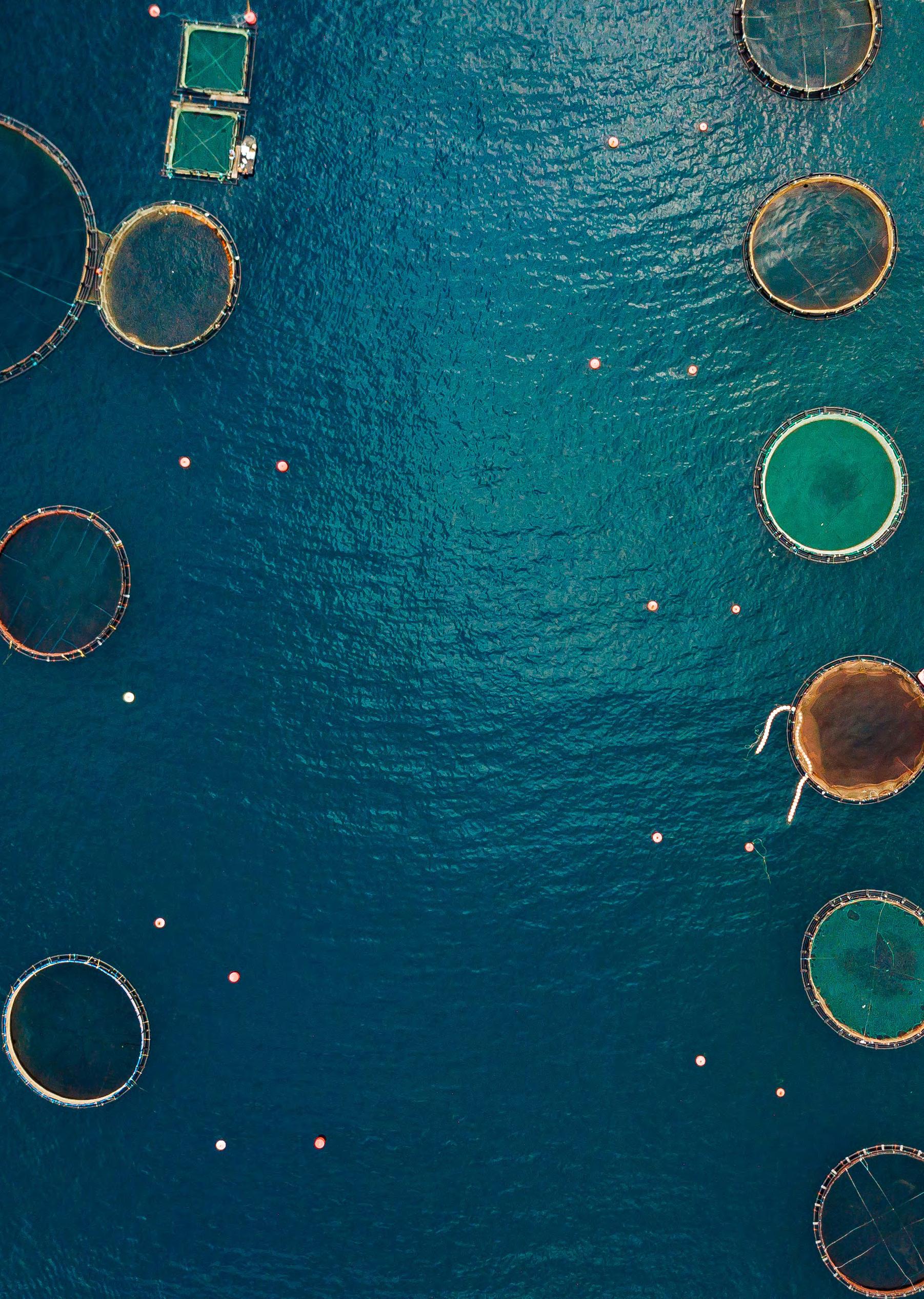
In this harsh environment, you’re forced to design and build differently if you want products to withstand the elements and bring workers home safely. Failure is simply not an option. “
Aerial view of a salmon fish farm
Maritime Feature
Hamilton Jet
CWF Hamilton & Co Ltd, (HamiltonJet) was formed in 1939, located at the workshop of Irishman Creek Station. During the early years the company pursued a policy of planned diversification, a natural progression from the effective innovation and expertise initiated by the founder Sir William Hamilton.
HamiltonJet grew out of a combination of CWF Hamilton Engineering and CWF Hamilton Marine, the two main subsidiary companies in the Hamilton Group. As the popularity of jet boats and waterjet propulsion increased rapidly throughout the 1960s and 70s, Hamilton Engineering was producing a large number of marine jet units along with its industrial equipment, cranes and hydraulics.
During the late 1970s and early 1980s, New Zealand underwent some major economic redirection and the company recognised the potential for waterjet propulsion systems. It made the decision to phase out the industrial side of Hamilton Engineering to concentrate on the production of waterjet units and hydraulics. For over 40 years the company has focused only on the waterjet side of its business becoming the leading specialist waterjet and controls manufacturer in the world.
HamiltonJet company offices were opened in America, the UK and Singapore to market and coordinate the distribution and spare parts support of waterjets in those regions.
Continued growth in demand for HamiltonJet Waterjets has seen numerous factory expansions in the last decade. Manufacturing floor space has increased to 17,000 square metres on the 6.88 hectare site, with new machinery installed and staff hired to increase factory capacity by more than 50%. HamiltonJet currently has 20 different jet models starting from 270kW up to 5,500 kw in maximum power rating and our market experience is extensive. As a preferred supplier to boat builders, naval architects and marine operators, we’ve installed over 60,000 waterjets into vessels around the globe, including offshore, pilot, rescue, fire, military, patrol, windfarm, fast ferry, fishing, aquaculture and recreational applications.
We’re willing collaborators and integrators, working in the best interests of our clients to deliver everything from standard to bespoke solutions that work for them. Our products are designed and built to the standards of the world’s leading certifying authorities. They’re manufactured in-house at a modern plant with cutting-edge machining facilities and extensive testing and inspection procedures.
All our products are backed by class-leading after sales support. Wherever you are in the world, you’ll find extensive parts stocking and experienced HamiltonJet distributors supported by our own regional office staff. We also guarantee at least 20 years’ support at the end of series production.
Today, HamiltonJet is still a family owned company employing over 440 staff in all aspects of waterjet design, production, sales and service and has over 55 Distributors around the world as part of the company’s global reach program.
The company has also recently celebrated its 80th year Anniversary and is looking towards strong growth in the future.
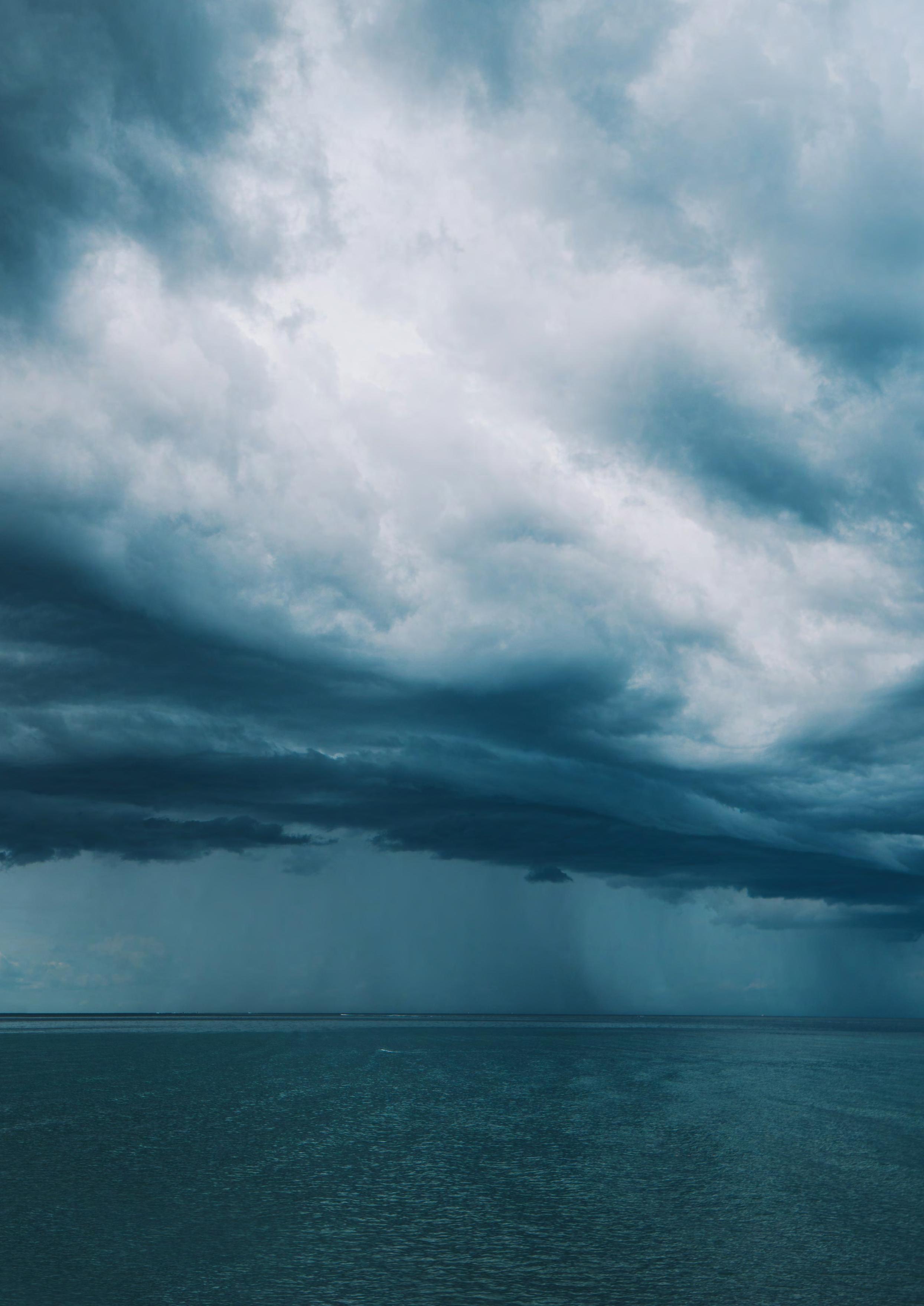
www.hamiltonjet.com
PFG
Plain Sailing
As well as its expertise in aquaculture, PFG has capabilities in commercial marine. This includes the provision of workboats, safety gear, buoys and fenders, and anchors and shackles. Of its 40 years in business, 25 of those have been spent with a marine offering. “Our first vessel, a work boat built 25 years ago, is still in full commercial use on a Tasmanian fish farm,” said Mr Inches, “it still has many years of life left, but the beauty is, if the customer is ever ready to decommission it, the material can be recycled into another project”.
A major development for PFG is its evolution into fast response vessels for the emergency services and defence market.
A few years ago, PFG spotted a niche. In partnership with One2three naval architects, the company perfected the design and construction of incredibly durable, stable and safe work boats for harsh ocean environments, using high-density polyethylene (HDPE). At the same time, the boats were incredibly manoeuvrable and highly customisable.
This combination of safety and performance made the vessels perfect for emergency and defence use cases.
“HDPE outperforms alternative watercraft alloy or composite material in that it’s incredibly durable and impact-resistant, it won’t corrode or perish with exposure to salt water, UV or long storage periods, and it can be fixed in-situ without needing any hot works,” said Mr Inches, “It can handle sustained force, submerged obstacles, air drops and hard beaching.”
In March 2022, PFG despatched three flood rescue boats for the Western Australian Department of Fire and Emergency Services as part of a 10-boat contract. The business has also recently won a contract to build three 12.5 metre speciality watercraft for the New Zealand Defence force.
“
“We have been on a campaign to break into this market for the last 3 years,” explained Mr Inches, “as part of this we established a defence capability advisory committee. This helped us to understand the needs of the sector”.
One of these specific needs is a more mature procurement process than other marketplaces, and an invaluable understanding of how to engage with defence market customers.
Standing Sentinel
PFG unveiled its flagship vessel, the Sentinel 1100, at the Indo Pacific International Marine Exposition 2022.
Pitched at elite defence and security organisations, the Sentinel 1100 is the pinnacle of PFG and One2three’s expertise in high-performance, high-safety tactical vessels. It features PFG’s Vigilant Safety System, which uses a combination of design factors and invigilation technology for monitoring, observation, and cloud-based data analysis. The Sentinel 1100 can be fully networked with command and control frameworks and can even be operated autonomously.
HDPE absorbs noise and vibration, providing obvious benefits to both passengers and crew. “We’re passionate about showing our clients the condition and care HDPE has to offer,” Mr Inches explained, “we’ve employed technology to support and monitor loads that are being transferred to passengers and crew. These people are being sent out into hostile environments, so it’s our responsibility to ensure their safety from our end”.
PFG
Sustainability at Sea
“Of its many benefits, HDPE also offers a lower footprint than some traditional materials,” said Mr Inches, “it’s also fully recyclable.”
In addition to PFG’s use of low carbon footprint HDPE, it also offers a rotational moulding facility. “This is an important offering for us, particularly when customers request a recycled product. It means we can cater for it in house”.
Mr Inches also highlights how there is opportunity for PFG to expand its footprint in the sustainability sphere. “An evolving market at the moment is seaweed farming. With our experience and the expertise of our R & D team, we certainly feel we could offer innovative solutions to this growing space,” said Mr Inches. Seaweed has many benefits to the environment, including carbon capture and the ability to reduce cattle emissions by forming part of the animal feed.
Credentials
It’s crucial that PFG works closely with its clients to produce bespoke solutions. In fact, its PFG’s mission “to drive a sustainable future by creating value for our customers through partnerships, professionalism and collaboration”.
Clients of PFG include Tassal, Steer Group, New Zealand Defence Force, and Australian Maritime Safety Authority to name just a few. In addition, it has formed partnerships with the likes of, Dainichi Corporation and One2three Naval Architects.
MEETING THE CHALLENGE
Our waterjets and controls represent the pinnacle of high thrust capability, agile maneuverability and superior durability, delivering absolute confidence for wind farm support vessels the world over. www.hamiltonjet.com
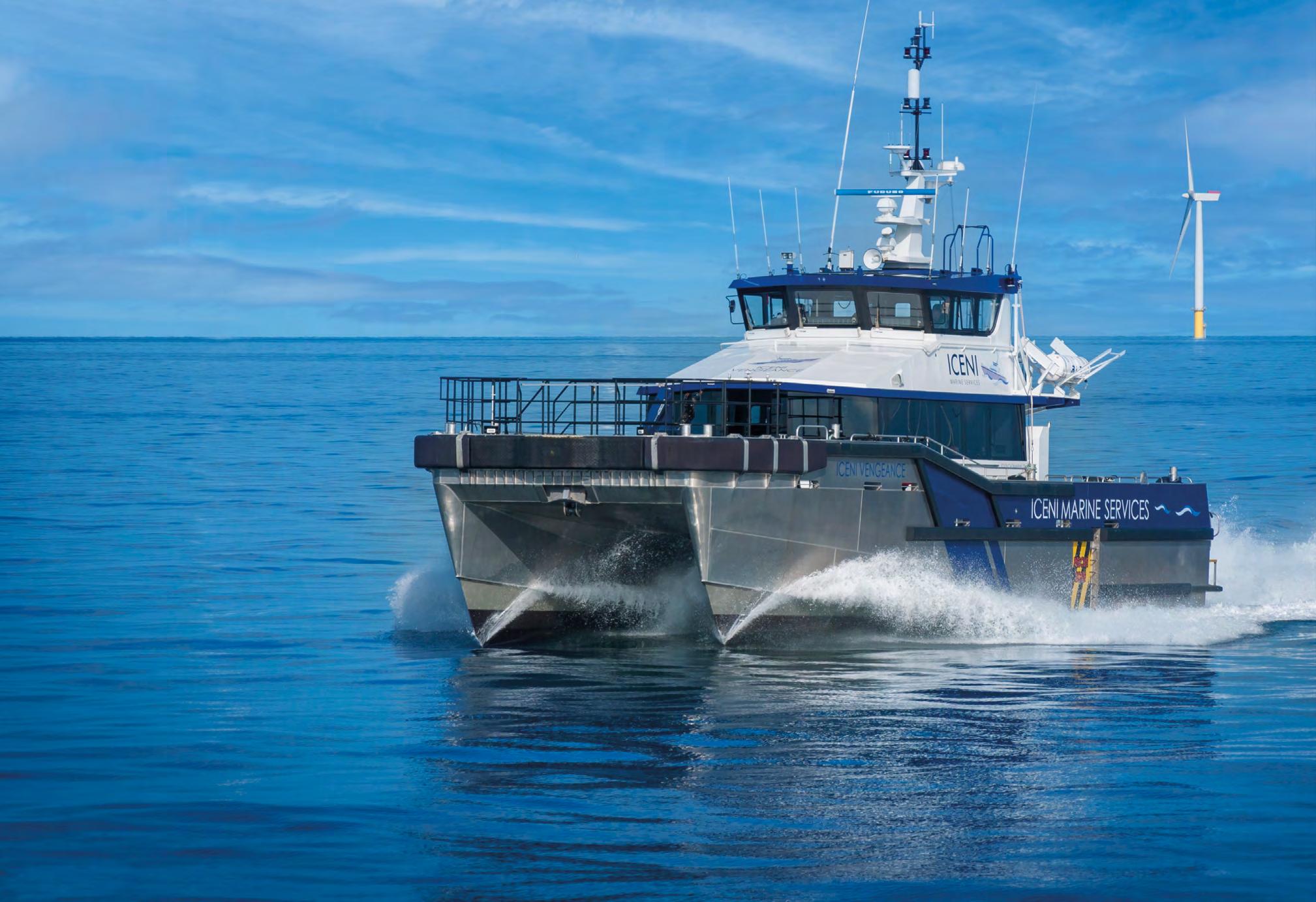
Maritime Feature
PFG’s new Sentinel 830 craft, in the background Mt Wellington
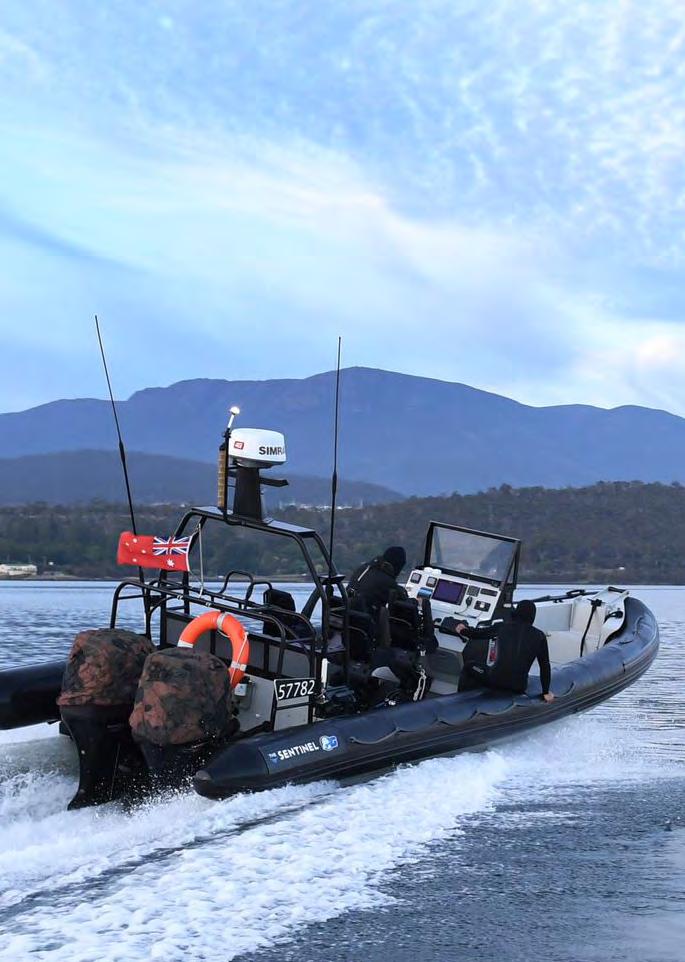
Maritime Feature
PFG prides itself on providing technology-led innovation - this hasn’t gone unnoticed in the industry. Over the years PFG has built quite the trophy cabinet.
Most recently, PFG was named Ausmarine Baird Maritime Work Boat World Best RIB Patrol Boat 2020 and Ausmarine Best Patrol Boat 2019. In addition, PFG’s support vessel and survey vessel has been named best in class. The business also holds the titles of Best Speciality Boat Builder (Ausmarine, 2014), Best Aquaculture Boat Builder (Ausmarine, 2013) and Best Speciality Boat Builder (Ausmarine 2012).
An intelligent step forward
As well as developing its sustainability output, the team at PFG will be investigating how to integrate the latest technology into its builds. This will include R & D into autonomous and artificial intelligence as well as signature management. Once again, PFG will look to utilise its existing and new partners and customers to develop this offering. “I don’t believe you can underinvest in new tech or digital 4.0,” shared Mr Inches, “I think anyone that underestimates this will find their business disrupted or displaced”.
pfg-group.com.au
PFG
